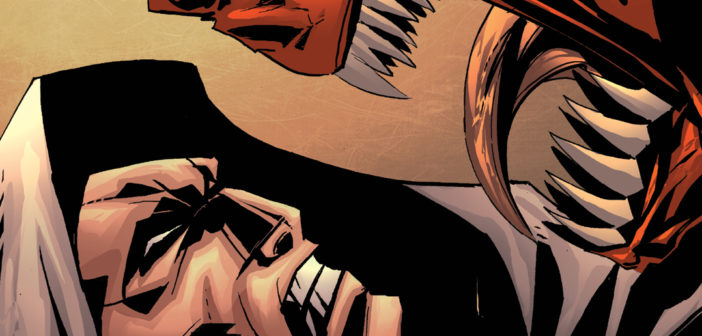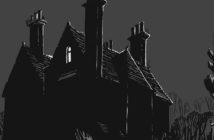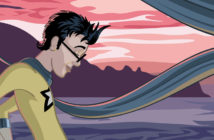After three issues and a year of publication, the fourth and final installment of Jamie Gambell and J.C. Grande’s Omnitarium has arrived. In it, writer Gambell brings his story to its quickly impending conclusion while artist Grande uses his harsh black-and-white illustrations to solidify the mood that the miniseries has created for itself: all things gothic.
Throughout the miniseries, the story of Omnitarium has recounted the happenings in the Pentansly Gaol, a Victorian prison that boasts its techniques for reforming prisoners as workers instead of simply locking them away. At the time the comic takes place, the Gaol is visited by a small group of aristocrats; they act as makeshift inspectors to find out of its marvels are true. But Pentansly is also a magnet for the supernatural, an unfortunate circumstance for its refined visitors.
Moonheart is the plague who uses his influence from beyond the grave to manipulate the inmates of the prison. His agenda is expected: he wishes to return from the grave after being executed by the witch-hunter Blutstein. This is more than the aristocrats can handle—their stuffy, bourgeoisie lifestyles have obviously not prepared them for the bloody workings of black magic. They find themselves, ironically enough, prisoners among prisoners. Some remain frilly, while the survival instinct in others kicks in. This is a premise that harkens back to classic gothic literate; think Matthew Lewis, author of The Monk, and Horace Walpole, author of The Castle of Otranto.
This fourth issue of the miniseries is true to the three that precede it. I’m able to appreciate Omnitarium the most as a work of atmospherics. The imagery of Grande as directed by Gambell creates an eerie spirit that is imperative for a story in this genre. Sometimes the lines of these types of stories are blurred: after all, what really is the difference of a gothic story versus a horror yarn versus a dark fantasy tale? Some might say nothing, but I disagree. Oh, the differences are nuanced, yes, but I see them here in this book. Omnitarium won’t scare anyone, but it will set a bleak mood.
The weakness of Gambell’s work as a whole is the amount of story he wants to tell versus the space he’s given himself. Four issues aren’t enough for what he wants to convey. I wonder if the resulting length was his decision or that of his publisher, Ronin Studios. Too many plot threads are frayed, and most are left unwoven when the book ends. I had a lot of questions that were never answered, and some of them were basic.
But I view Gambell and Grande’s Omnitarium as a beginning. It has set into motion perhaps later tales that take place in the Omnitarium world. And it has served as an important stepping stone for Gambell to write more gothic stories. Seeing his work up until this point, I think he’s more of a creator to focus on a true graphic novel, and not be so wrapped up in issue counts. Stories like his can’t be worried about quotas.
This comic book review originally appeared on Broken Frontier.




